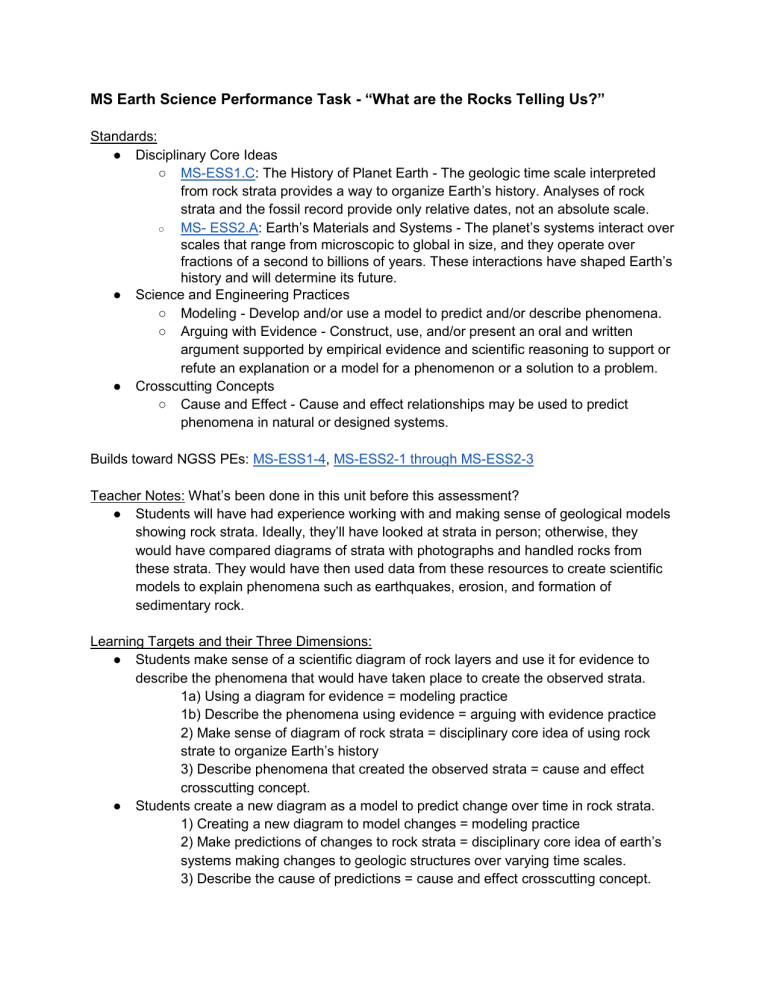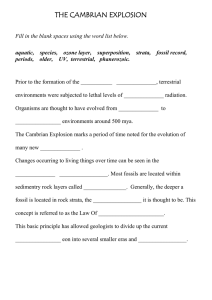
MS Earth Science Performance Task - “What are the Rocks Telling Us?” Standards: ● Disciplinary Core Ideas ○ MS-ESS1.C: The History of Planet Earth - The geologic time scale interpreted from rock strata provides a way to organize Earth’s history. Analyses of rock strata and the fossil record provide only relative dates, not an absolute scale. ○ MS- ESS2.A: Earth’s Materials and Systems - The planet’s systems interact over scales that range from microscopic to global in size, and they operate over fractions of a second to billions of years. These interactions have shaped Earth’s history and will determine its future. ● Science and Engineering Practices ○ Modeling - Develop and/or use a model to predict and/or describe phenomena. ○ Arguing with Evidence - Construct, use, and/or present an oral and written argument supported by empirical evidence and scientific reasoning to support or refute an explanation or a model for a phenomenon or a solution to a problem. ● Crosscutting Concepts ○ Cause and Effect - Cause and effect relationships may be used to predict phenomena in natural or designed systems. Builds toward NGSS PEs: MS-ESS1-4, MS-ESS2-1 through MS-ESS2-3 Teacher Notes: What’s been done in this unit before this assessment? ● Students will have had experience working with and making sense of geological models showing rock strata. Ideally, they’ll have looked at strata in person; otherwise, they would have compared diagrams of strata with photographs and handled rocks from these strata. They would have then used data from these resources to create scientific models to explain phenomena such as earthquakes, erosion, and formation of sedimentary rock. Learning Targets and their Three Dimensions: ● Students make sense of a scientific diagram of rock layers and use it for evidence to describe the phenomena that would have taken place to create the observed strata. 1a) Using a diagram for evidence = modeling practice 1b) Describe the phenomena using evidence = arguing with evidence practice 2) Make sense of diagram of rock strata = disciplinary core idea of using rock strate to organize Earth’s history 3) Describe phenomena that created the observed strata = cause and effect crosscutting concept. ● Students create a new diagram as a model to predict change over time in rock strata. 1) Creating a new diagram to model changes = modeling practice 2) Make predictions of changes to rock strata = disciplinary core idea of earth’s systems making changes to geologic structures over varying time scales. 3) Describe the cause of predictions = cause and effect crosscutting concept. “What are the Rocks Telling Us?” Name _____________________ This diagram will be the primary diagram used to answer the questions below. A - sandstone, B - limestone, C - shale, D - basalt. Image from: http://www.ck12.org/book/CK-12-Earth-Science-For-High-School/section/11.2/ Although different in many important ways, this photograph provides a sense of what the rock strata labeled D in the above diagram might appear like in an actual system. Image from: http://www.sci.ccny.cuny.edu/~mcesaire/earthhistory.html 1. Describe the geologic history of the rock layers in the top diagram - note which was formed first, second, third, and last and describe how you know. 2. What does E represent? Where did it happen on the timescale of the formation of these layers? 3. What is your evidence and reasoning to place E there on the timescale? 4. Recreate the initial diagram below to model what the rock strata might look like in one million years. Use your background knowledge to predict at least two reasonable changes. Below the model, explain why those two changes could happen. Rubrics Related to the Learning Targets Students make sense of a scientific diagram of rock layers and use it for evidence to describe the phenomena that would have taken place to create the observed strata. Basic Developing Proficient Advanced Students describe what is in the image (layers of rocks) and note that C is the oldest layer of rocks. Students use evidence from rock strata and their learning to explain that layer C is the oldest rock strata. Students use of evidence from the diagram and geological understanding to explain that strata D is the newest and what it likely is (volcanic intrusion) and explain why E (fracture) would be the newest feature. Students also extend their explanation to note uncertainties of models, predict future phenomena, or analyze competing explanations. Students create a new diagram as a model to predict change over time in rock strata. Basic Developing Proficient Advanced Students create a new diagram showing rock layers that is different from the original. Students’ diagram models plausible predictions of what could happen. Students’ diagram and explanation accurately model plausible predictions of what could happen, and include sufficient evidence-based reasoning. Students also effectively connect their modeling and explanation to a million year timeframe, clearly relating why that scale matters. Or, students reflect on the limitations of the model they create.





